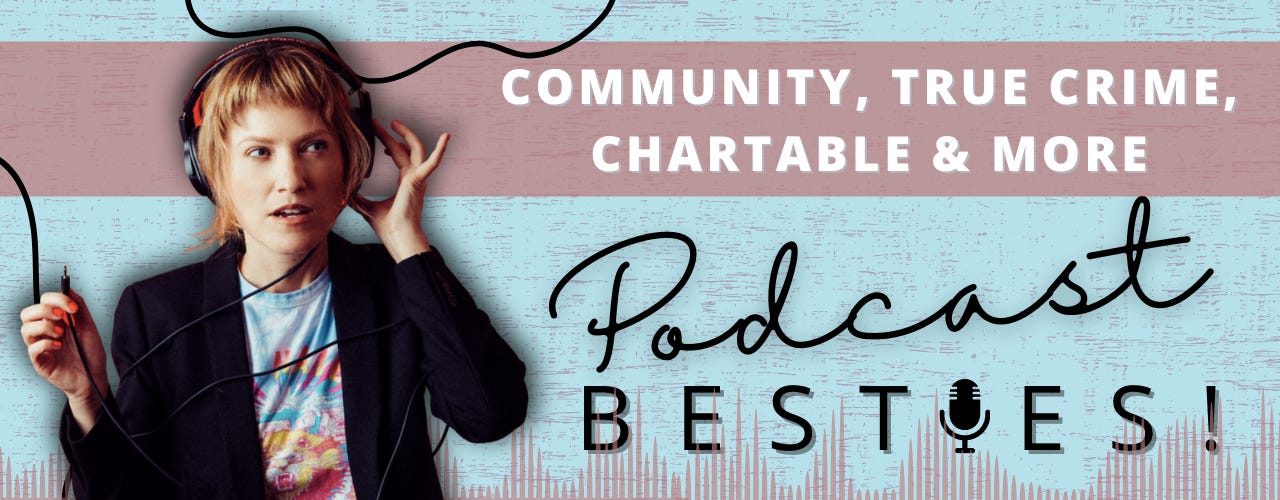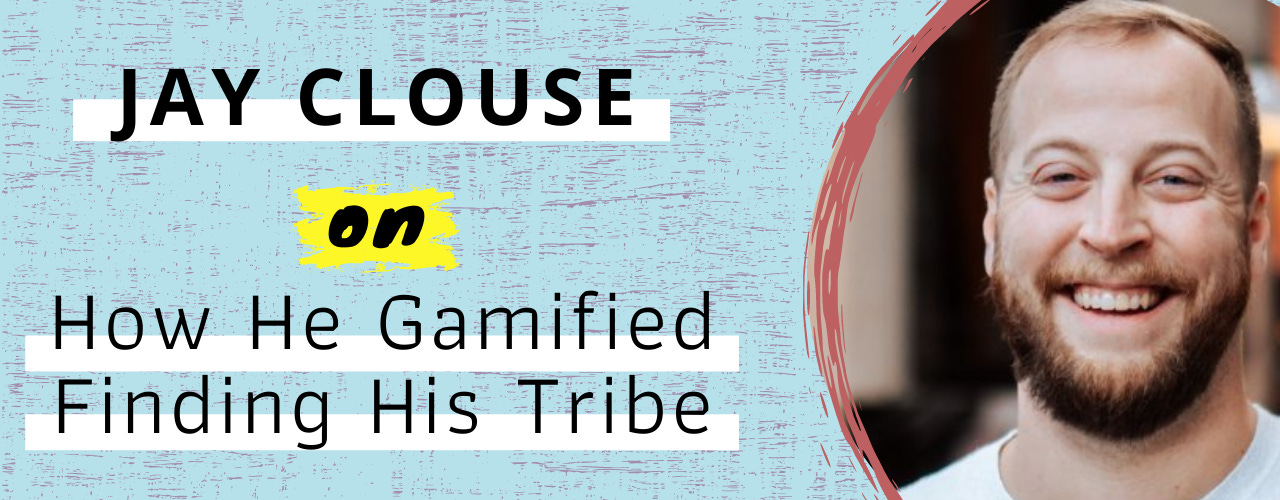Hi Besties!
This week, we have an interview with Jay Clouse that I’m really excited about, so we’re just going to dive right in. I first came to know Jay as the creator of #Tweet100, which you’ve probably seen if you spend any amount of time on Podcast Twitter. In fact, the very first Podcast Bestie interview was with Arielle Nissenblatt, who shared how the #Tweet100 challenge helped her gain a whopping 2,000 followers.
Shortly after, I started the #Tweet100 challenge myself, and it helped me develop a daily habit of popping on Twitter to connect with other podcasters for about six weeks. Then when the New Year rolled around, I reassessed my goals and adjusted my workflow to make more time for deep work — BUT, even though I stopped participating in #Tweet100 officially, I’ve noticed that the practice has stayed with me. I’ve been a more consistent Twitter connector ever since, and that’s definitely helped grow the community around this newsletter.
Our Q&A is about creating community, so this little anecdote seemed like an apropos way to kick things off… Enjoy!
Your podcast Creative Elements explores how top-tier creators and creative entrepreneurs do what they do best. As a creative yourself, what have you learned from your guests that you’ve been able to apply to your craft?
JC: Oh my gosh, so much. Sometimes I feel like a genius for creating an excuse to meet and learn from these brilliant creators! Mostly I’ve learned about patience. There’s a period of time when you’re starting out when consistency is really important — paramount. It helps you find your voice and build an initial audience. But once you’ve found your groove, quality matters a lot more if you’re trying to really be big. But nothing happens overnight for anyone. Everyone puts in the time to do GREAT work over a period of many, many years.
How do you think about and approach the concept of community as a podcaster and creator?
JC: Community is really important to me. I think about it as concentric circles (shoutout to the team at Commsor for their Community-Led manifesto because they nailed this). The widest circle is the overall market of people you could reach with your work. Inside that is your audience. Inside that are members — people who are frequently engaging with you — and inside that are what I call peers. As a podcaster and creator, I’m focused more on making the “members” circle bigger and letting THEM pull others from the market into my audience.
Why is community perhaps a better alternative to “the content treadmill”?
JC: I don’t know if there’s a way around being on the content treadmill to some degree if you’re going to be a professional creator. Maybe you can eventually step off and focus solely on your community… but odds are, you need to continue to create content for them. But my goal is now to serve my community SO well that they evangelize for me, instead of focusing on attracting a new audience and meanwhile ignoring my closest supporters.
We’re more connected than ever, yet loneliness is so prevalent in our modern times — it makes sense that community could be as valuable (or more valuable even) than the content itself. How do you offer your community value, and what benefits do you find they’re most attracted to?
JC: I’m just getting into this for my own work. My overall business is called Creative Companion, and my goal is to help people become professional creators. Not just dabblers, but creators who actually earn an income from their work. My biggest project this year is my new Creative Companion Club, a membership for creators who are ready to go pro. Inside that community, I’m offering a lot of my personal time and attention. But one of the biggest drivers of value is that my content is a lightning rod for other professional creators. So members know that when they join the community, I’m doing the work of curating a room of other incredible creators who you can collaborate with and learn from.
So having an engaged community is great, but HOW do you facilitate that as a creator? What’s your strategy for designing an effective community?
JC: It’s so hard. Most of community building is about modeling behavior. As the facilitator in the community, you need to SHOW the other members (through your actions) what it looks like to participate in the community. And when another member models that behavior, you need to recognize it and pour love on them. It’s probably six months of work to do this over and over and over until the culture of the community begins to build and self-perpetuate. It just takes a huge investment of time and energy on your part, being the glue between people, creating conversations, PERSONALLY answering questions, and building relationships between other people within the community.
Has #Tweet100 been an incredible tool for you to attract new members to your community? What motivated you to start #Tweet100?
JC: It has! Actually, it’s been an incredible tool for attracting people to my podcast, Creative Elements. When someone joins the #Tweet100 challenge, I send them a short email sequence to help them get started — and one of those emails includes two interviews I hosted on the podcast with a couple of Twitter geniuses. But I started #Tweet100 because I saw positive results every time I put some time and effort into Twitter. But I just couldn’t motivate myself to be consistent on the platform. So… I gamified it! Not just for me, but for the public, as well.
Yeah, the gamification really helps! Has #Tweet100 inspired new ideas for your own podcast or other content? If so, how?
JC: Not much. Mostly it’s shown me how powerful a free, public challenge can be. And it’s been so easy to grow. It’s taught me that not everything has to feel so hard... When something is valuable and attainable, it spreads on its own.
How did #Tweet100 alter your social media habits for better or worse?
JC: I’m definitely more consistent at writing on Twitter. That was the muscle I was trying to build, and that definitely happened. I probably over-index on creating on Twitter, though, and not spending enough time reading and engaging with others’ work.
I saw that you recently took (are taking?) a video course. How do you approach adding a new skill to your creative toolbox?
JC: This has been such a great experience — shoutout to Kevin and his Dream Studio Course. The hardest part of adding a new skill to your creative toolbox is accepting that you will be bad to start. The more you can immerse yourself in learning though the faster you can learn.
Anything else you’d like to add?
JC: Listen to Creative Elements! If you’re interested in being a professional creator, this podcast is the way.
Thank you, Jay!
➡️ For all things Jay Clouse, head to jayclouse.com.
➡️ Of course, give him a follow on Twitter, and sign up for #Tweet100 if you need a good excuse to become more active on social media.
➡️ And listen to his podcast Creative Elements for more words of wisdom!
YouTube is Offering Podcasters $50,000+ to Create Videos - A recent Podcast Bestie highlighted the striking number of listeners that discover podcasts through YouTube — and according to Bloomberg and The Verge, YouTube is now offering podcasters grants to produce videos of their shows. Individual show creators would receive $50,000, while podcast networks would receive $200,000 or $300,000.
A Good Argument for Why Podcasters Should Be on TikTok - This Rephonic article analyzed data across social channels with accounts linked to podcasts and found that shows utilizing TikTok have a higher average follower count, among other social media insights. Depending on the demographics of your audience, creating a TikTok could be a no-brainer!
Damn, Women Love True Crime - Women have a stalker-like obsession with the genre, as this study from Triton exhibits. However, check out which other podcast genres are quickly becoming fan favorites among ladies who need an occasional break from all the murder.
Another Take on Why Spotify Bought Chartable and Podsights - These acquisitions have been a hot topic from the moment Spotify snatched them up. According to Om Malik, they seem to emulate other highly successful tech mergers that changed the game. (Check out my recent mini-interview with Bryan Barletta for more on this.)
A Brand Lift Study That Illustrates How Podcast Advertising Works - An interesting look into how an auto manufacturer used a podcast ad campaign to target a particular audience. It showed increases in favorability and purchase consideration. Go ahead and link this next time you’re pitching a new sponsor!
Associate Producer, Conviction (full-time) at Gimlet Media | Brooklyn, NY
Field Producer/On Air Reporter, The Laura Flanders Show (full-time) at American Public Television | Remote
SEO Specialist (full-time or part-time) at The Podcast Host | Edinburgh, Scotland, UK + Remote
Growth Marketer (full-time) at The Podcast Host & Alitu | Remote
Executive Producer, Meditative Story (full-time) at Wait What | New York, NY
Producer (full-time) at Transmitter Media | New York, NY
DEATH NOTE - INTRODUCING ÍDOLO: THE BALLAD OF CHALINO SANCHEZ - I’ve been meaning to check out this new Erick Galindo joint, and oh boy! This eight-part series is a thrilling combination of celebrity, drug cartel, the Mexican-American music industry, and a murder mystery for the ages.
PRINCESS OF SOUTH BEACH: THE ACCIDENT - I worked with Jasmine Romero during my time at Endeavor Audio, and it’s been awesome to see (and hear!) her success unfold ever since. Princess of South Beach is an entertaining take on the classic telenovela tropes. Kudos, Jasmine!
THE EXPERIMENT: ONE AMERICAN FAMILY’S DEBT TO UKRAINE - My effort to follow Russia’s war in Ukraine without going insane continues and this ep offered some unique and humanizing insight. As Putin invaded Ukraine last month, he referred to the “Nazification” of Ukraine: a distortion of history at best. But the Atlantic writer Franklin Foer found his justification uncanny; his grandmother had been telling him a similar story his whole life. This episode tells the story of the Holocaust survivor Ethel Kaplan and traces Foer’s own journey — how he first came to believe Putin’s myth and his trip to Ukraine to debunk it.
Now it’s your turn… Help me expand my listening playlist by submitting for a Play It Forward feature!
➡️ Here’s the link to submit for future editions.
So… ROLL CALL! 🗣
In the spirit of creating community, I’d like to get to know more of you. Are you a podcaster, in the industry, and/or a beloved podcast fan? Introduce yourself and your favorite food!
🙋 I’ll go first: My name is Courtney Kocak, my podcast is called Private Parts Unknown, and lately, I’ve been eating like four or five oranges a day! 🍊
Follow me @courtneykocak on Twitter and Instagram. For more, check out my website courtneykocak.com.








